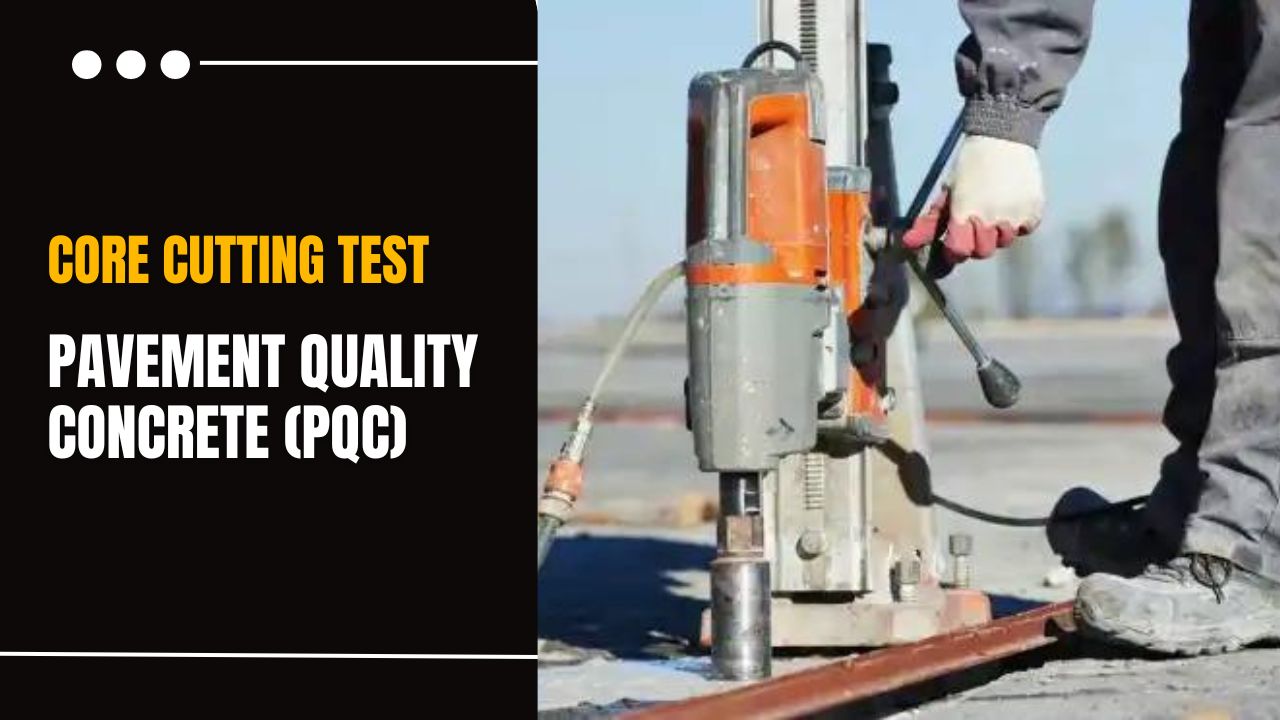The Core Cutting Test for Pavement Quality Concrete (PQC) involves drilling cylindrical cores from a pavement using a diamond core cutter. These cores are then tested for compressive strength, density, and visual defects to assess the quality of the in-situ concrete. The results guide decisions on maintenance, repair, or rehabilitation of the pavement, contributing to its longevity and safety.
Core Cutting Test for Pavement Quality Concrete (PQC):
Objective:
The objective of the Core Cutting Test for Pavement Quality Concrete (PQC) is to comprehensively evaluate the quality and integrity of in-situ concrete within pavements. This test aims to assess various key parameters, primarily focusing on the determination of the concrete’s compressive strength, thickness, and overall condition. By strategically extracting cylindrical cores from different locations within the pavement, the test provides a representative analysis of the concrete’s properties. The diamond core cutter ensures precise sampling without compromising the integrity of the cores. The results obtained from testing these cores offer valuable insights into the in-place strength of the concrete, potential defects, and the overall performance of the pavement structure. Ultimately, the objective is to make informed decisions regarding the maintenance, repair, or rehabilitation of the pavement, contributing to its durability, safety, and long-term functionality.
Equipment:
The equipment used in the Core Cutting Test for Pavement Quality Concrete (PQC) includes specialized tools designed for the extraction and testing of cylindrical cores. The primary equipment consists of:
- Diamond Core Cutter: A drilling machine equipped with a diamond-tipped core cutter is used to extract cylindrical cores from the pavement. The diamond cutting edge ensures precision and minimizes damage to the extracted cores.
- Core Extraction Tools:Tools for carefully extracting the cylindrical cores from the pavement without compromising their structural integrity. This may include core barrels, core extractors, or similar devices.
- Measuring Instruments: Instruments for measuring the diameter and length of the extracted cores. This ensures accurate recording of core dimensions, which is crucial for subsequent testing and analysis.
- Testing Apparatus:Various testing apparatus for assessing the properties of the extracted cores, such as compressive strength testing machines and devices for density measurement.
- Safety Gear:Personal protective equipment (PPE) including safety goggles, gloves, and appropriate clothing to ensure the safety of personnel involved in the core cutting process.
- Documentation Tools:Tools for recording and documenting key information, such as field notebooks, cameras, or electronic devices for capturing images and notes during the core cutting process.
- Water Supply:In some cases, water may be required for cooling the diamond core cutter during the drilling process to prevent overheating and maintain cutting efficiency.
- Transportation and Storage Containers:Containers for safely transporting and storing the extracted cores to the testing laboratory for further analysis.
Procedure:
- Core Extraction: Select representative locations for core extraction. Drill cylindrical cores from the pavement at the desired depth using the diamond core cutter. Cores are usually taken from different sections of the pavement to ensure a comprehensive assessment.
- Core Preservation: Carefully extract the cores to preserve their integrity. The extracted cores are typically 4 to 6 inches in diameter, depending on the project specifications.
- Testing: Conduct various tests on the extracted cores, including compressive strength testing, density testing, and visual inspection for any signs of distress or defects.
Analysis:
- Evaluate the test results to assess the quality of the concrete and the overall condition of the pavement.
- Core test results can provide information about the in-place strength of the concrete, potential defects, and the overall performance of the pavement structure.
Interpretation:
The results of the Core Cutting Test can be used to make informed decisions about the need for maintenance, repair, or rehabilitation of the pavement.
Documentation:
- Record and document the core cutting test results for future reference and analysis.
It’s important to note that the specific procedures and standards for core cutting tests may vary depending on regional or project-specific requirements. Always refer to relevant standards and specifications for accurate and reliable testing.
This type of testing is crucial for ensuring the longevity and safety of pavement structures, as it provides valuable insights into the condition of the concrete and helps in making informed decisions regarding maintenance and rehabilitation.

